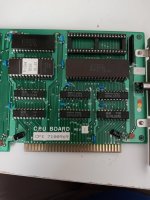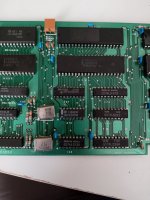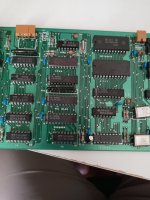I didn't find a chip of that number on the board. But I did a little basic investigating of my own, and seem to have fixed things in a way that disables the reset.
Of course, the answer I find so infuriating on any forum of any inquiry of an electrical problem is, "it's probably a bad capacitor." Not because that answer is wrong, but because it's practically useless. Anyone can give that answer. So - knowing the likely thing to fail is a capacitor, I traced the reset button to a capacitor, and removed it.
Played my first full game of PC Donkey Kong in a long time - before the fix, it always resets before I can get a game over. And screw that youtube video that calls the PC version of Donkey Kong the worst - you just have to know how to play it. Step 1, don't use a joystick.
Anyways - don't know if the capacitor I removed is bad, or if I just disabled something that makes another bad component no longer effect things. I suppose the next step if I wanted to fully restore things would be to try putting a new capacitor in place, and see what happens. But right now I'm just happy to have things working stable once again - to be honest, not having the reset button on the back of the PC working really isn't a big deal. Not like I used it all that often, usually if a reset is needed a ctrl-alt-delete does it. And if not, the big red on/off switch is closer to reach than the reset button. I don't think I ever pressed that button once on the family PC we had in my years of using it. So - it's a project for another time, that I might never get to, due to it being low priority.
What's of a higher priority is tracking down a set of binders and disks for the thing. Until then, I'll never know if my battery replacement was successful and allows the thing to hold onto the current date and time.




